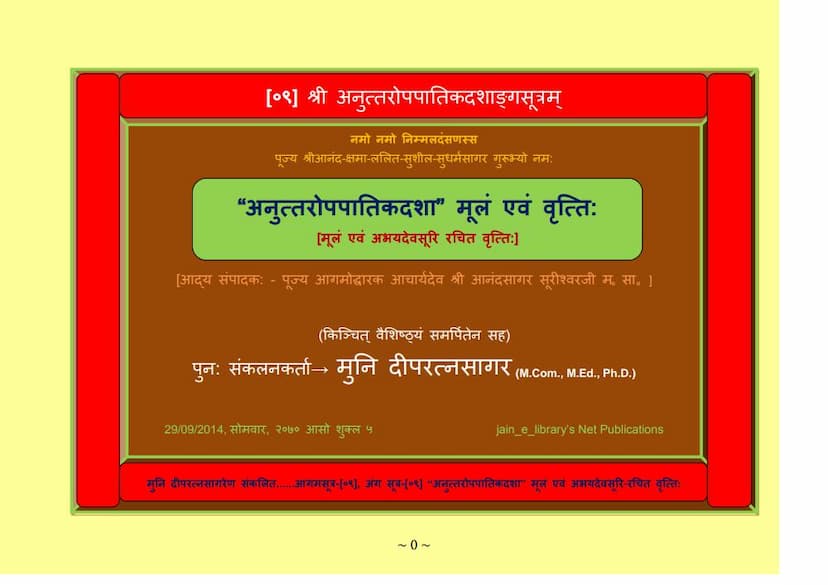Aagam 09 ANUTTAROPAPATIK DASHA Moolam Evam Vrutti
Added to library: September 1, 2025
Loading image...

Summary
Here's a comprehensive summary of the provided Jain text, "Aagam 09 ANUTTAROPAPATIK DASHA Moolam evam Vrutti":
This document is a republication of the Anuttaropapatikdashanga Sutra, the ninth Anga (limb) of the Jain Agamas. The core of this publication is the original text (Moolam) of the Sutra, accompanied by the commentary (Vrutti) written by Abhaydev Suri.
Key Aspects and Content:
- Title: "Anuttaropapatikdasha" (अनुत्तरोपपातिकदशा)
- Author of Vrutti: Abhaydev Suri (अभयदेवसूरि)
- Publisher and Editor (Original Publication): The original edition was published by the Agamoday Samiti in 1920 CE (Vikram Samvat 1976), edited by Acharya Dev Shri Anandasagar Surishwarji (Saganandasuriji Maharaj Saheb).
- Compiler and Editor (Current Publication): This specific version has been recompiled and published by Muni Diperatnasagar (M.Com., M.Ed., Ph.D.). He notes that this edition is a scanned and reformatted version of the 1920 publication, aiming to preserve its sanctity and accessibility.
- Purpose of Recompilation: Muni Diperatnasagar explains his motivation. He observed that some later publications had merely reprinted the previous edition without significant additions, sometimes even obscuring the original editor's name. His intention is to serve the Agamas by making this important text widely available in a clear and organized manner, utilizing modern digital platforms.
- Structure and Features of the Publication:
- Preserves Original Text: The core of the publication is the original text of the Anuttaropapatikdashanga Sutra.
- Includes Abhaydev Suri's Commentary: The comprehensive commentary by Abhaydev Suri is included, providing detailed explanations.
- "Deep Anukram" (Deep's Index): A unique indexing system, "Deep Anukram," has been created by Muni Diperatnasagar. This system helps readers navigate the text across different publications and languages (Prakrit, Sanskrit, Hindi, Gujarati, English), ensuring consistency.
- Page Numbering and Verse/Sutra Identification: The publication clearly indicates the original verse/sutra numbers and differentiates between prose (Sutra) and verse (Gatha) sections.
- Content Organization: The text is divided into ten studies (Dash Adhyayanani), which are further categorized into three sections (Varga):
- Varga 1: Contains 10 studies, starting with names like Jali, Mayali, Upayali, Purushsena, etc. (Pages 5-7).
- Varga 2: Contains 13 studies, including names like Dirghsena, Mahasena, Lathadanta, etc. (Pages 7-8).
- Varga 3: Contains 10 studies, such as Dhanya, Sunakshatra, Rishidas, Pellak, etc. (Pages 8-19).
- Detailed Footnotes: Numerous footnotes are provided at the bottom of pages to clarify specific terms, explain the context of certain discussions, point out printing errors from the original edition, or offer insights into numbering conventions.
- Digital Format: This is an "internet publication" of jain_e_library.org, designed for broad accessibility.
- Core Subject Matter of the Anuttaropapatikdashanga Sutra:
The name "Anuttaropapatikdasha" itself means "The states of rebirth in the highest (Anuttara) realms." The Sutra primarily deals with:
- Anuttara Vimanas: Descriptions of the highest celestial abodes (Vimanas) where beings are born without any further possibility of falling to lower states (Anuttara-Upapata).
- Lives of Ascetics: It narrates the lives and spiritual journeys of various ascetics who achieved liberation or are destined for it from these exalted realms. The text details their renunciation, austerities, and eventual rebirths in heavenly abodes, culminating in liberation.
- Examples: The content highlighted in the provided pages includes stories of:
- Jalikumar (Jali): His story from the first study.
- Dirghsena and others: Stories from the second section.
- Dhanya (Dhanya Angar): A significant portion of the provided text details the extreme austerities and physical emaciation of the ascetic Dhanya, illustrating his dedication to spiritual practice. His rigorous penances and the resulting physical transformation are described in vivid detail through numerous similes comparing his body parts to withered objects. This section also includes his ultimate liberation.
- Sunakshatra (Sunakshatra Angar): The story of another ascetic, Sunakshatra, is also presented, following a similar pattern of renunciation, austerities, and eventual rebirth.
- Theological Concepts: The Sutra implicitly and explicitly discusses concepts of karma, rebirth, austerities (tapas), renunciation, and the path to liberation (moksha) within the Jain framework.
- Significance: This Sutra is considered crucial for understanding the lives of those who attain the highest forms of rebirth and eventually achieve liberation, offering profound insights into the spiritual path.
In essence, this publication is a meticulously recompiled and annotated edition of a vital Jain scripture, made accessible through modern means while honoring its historical and spiritual legacy.